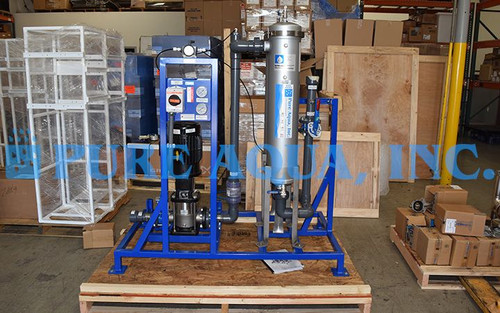Date: March 2013
Country:Ghana
System/Product: Water Filtration Plant
Flow Rate: 120 GPM
Components & Brands:
- Multimedia filter
- Activated carbon filter
- Twin water softener [SF100F series; Model #WSF48-1200-4-T]
- UV sterilizer
- Cartridge filtration
- 42" FRP duples tanks [MF600 series]
- Aquamatic valves and digital stagers
- Interconnecting pipes and wiring
[custom-specifications]
Large concentrations of suspended solids present results in a reduction in water quality. This outcome occurs in the form of turbidity which produces undesirable effects such as color alterations, smell, and taste issues in the water. Scaling can also result due to suspended solids and significantly hampers the performance of equipment and utilities utilized across industries. For these reasons, multimedia filtration systems are depended upon within applications that require high quality treated water. Media filtration has proven to be the most effective treatment method in regard to suspended solids reduction.
[/custom-specifications]
[custom-features]
Pure Aqua successfully manufactured and supplied a water filtration plant to a major hotel in Ghana to remove particulates, chlorine, organics, odor, hardness, and bacteria from well water. The water filtration plant is composed of multimedia, activated carbon, water softener, UV sterilizers, and cartridge filtration. The multi-media and activated carbon filters were selected from our MF-600 Series and both used 42” diameter FRP tanks. Both came with duplex arrangements, aquamatic valves and digital stagers along with interconnecting piping and wiring. The twin alternating water softener was selected from our SF-110F series, model # WSF48-1200-4-T. This twin alternating arrangement also came with aquamatic valves and digital stagers along with interconnecting piping and wiring. All were chosen to handle a flow rate of 120 GPM.
Since its startup, the water filtration plant has been running smoothly with minimal trouble-shooting. For satisfactory results, the plant utilized the following grades of media: Silica Sand, Anthracite, Activated Carbon, and Resin.
Silica Sand is a highly effective filter media because of its capability of holding back precipitates containing impurities. It is specifically graded for water filtration plants. Silica Sand’s fundamental characteristics include Filter sand size, hardness, and angularity. These characteristics guarantee proper filtration.
Anthracite is a black coal that has been recognized as a potential water treatment since the ancient times. When it is crushed, Anthracite makes an exceptional medium density filtration media. Its cracked shape allows some sediments to deeply penetrate into the bed. Anthracite is known to have extensive filter runs and fewer head loss. Also there is a reduction in backwash rates.
Activated Carbon is a black firm element that is similar to powdered and granular charcoal. It is consists of many pores with a very large surface area. Activated Carbon is known to effectively remove chlorine and some heavy metals bound to organic molecules. It has been found that activated carbon eliminates much more contaminants from water than regular carbon.
Resin is an insoluble support structure that usually comes in the form of small beads created from an organic polymer substrate. Resin’s structure is highly porous on the surface which are sites with easily trapped and released ions. They are widely used in processes such as separation, purification, and decontamination. Water softening and water purification are common examples of Resin.
Multi-media filters are manufactured to do away with suspended particles from water and service feed water with a turbidity of up to 20 NTU. In the filtration process, small particles descend down to tinnier and finer media levels. The cracks within these filters catch particles as low as 10 microns. The blocked larger particulates are caught on top of the filtration bed. At times multi-media filters are backwashed when there is an increase in pressure differential or when a timer begins. Activated carbon filtration systems use carbon draws attention to chemicals and impurities. Carbon has a little electro-positive charge added to it, so when water passes over the positively charged carbon surface, the contaminants negative ions are drawn toward the surface of the carbon granules. Activated carbon water filters remove impurities, odors, and colors from water.The two most significant factors affecting the efficiency of activated carbon filtration is the amount of carbon in the system and the amount of time the contaminants stay in contact with the carbon.
[/custom-features]
[custom-usage]
- Reduced costs / Material use.
- Less power consumption.
- Longer life span of plant equipment
- Decreased cost of repair & maintenance.
- Greater water quality
[/custom-usage]
Water Filtration Plant 120 GPM - Ghana - Case Study
-
High efficiency
It removes turbidity with high efficiency
 ENGLISH
ENGLISH
 ESPAÑOL
ESPAÑOL ???????
??????? PORTUGUÉS
PORTUGUÉS FRANÇAIS
FRANÇAIS
















